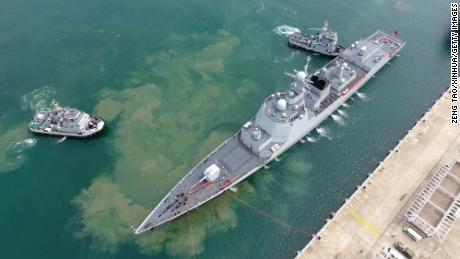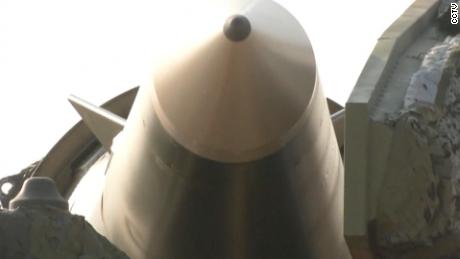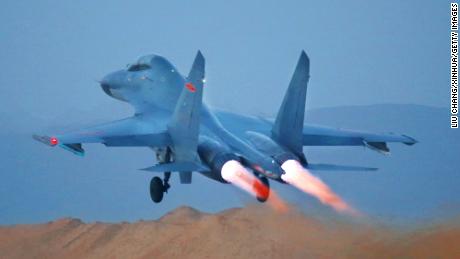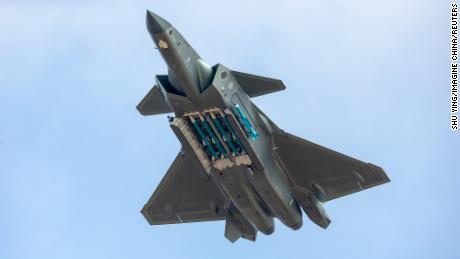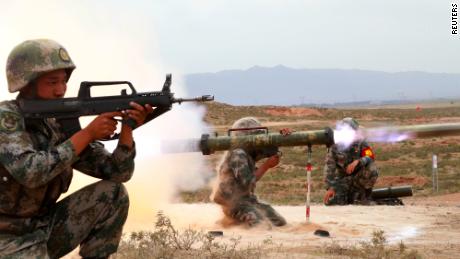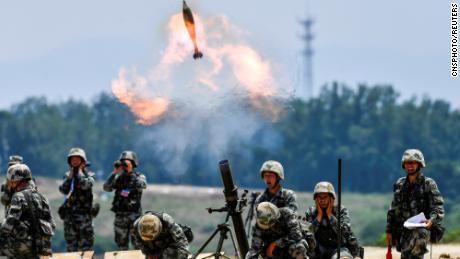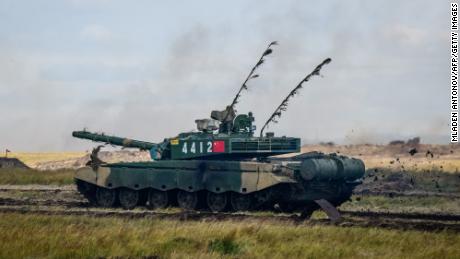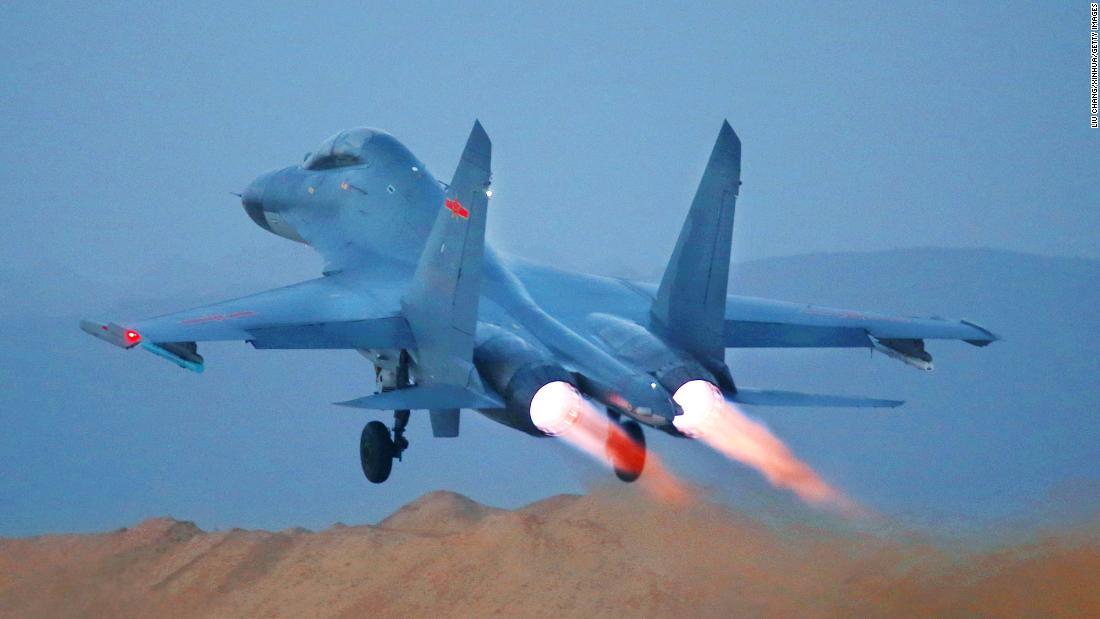
It’s the third time Biden has made similar remarks since taking office and, just as on the other two occasions, they were quickly walked back by the White House — which insists its policy has not changed. However, it inevitably raises the question: if China tries to take Taiwan, are the United States and its allies able to stop it?
And the alarming answer is: Quite possibly not. Analysts say China has more troops, more missiles and more ships than Taiwan or its possible supporters, like the US or Japan, could bring to a fight. That means that if China is absolutely determined to take the island it probably can.
But there’s a caveat; while China could likely prevail, any victory would come at an extremely bloody price for both Beijing and its adversaries.
Many analysts say an invasion of Taiwan would be more dangerous and complex than the Allied D-Day landings in France in World War II. US government documents put the number of killed, injured and missing from both sides during the almost three-month-long Normandy campaign at almost half a million troops.
And the civilian carnage could be far, far worse.
Taiwan’s population of 24 million people is packed into dense urban areas like the capital Taipei, with an average of 9,575 people per square kilometer. Compare that to Mariupol, Ukraine — devastated in the war with Russia — and with an average of 2,690 people per square kilometer.
Despite its numerical advantages in sea-, air- and land-based forces in the region, China has Achilles heels in each arena of war that would force Beijing to think long and hard about whether an invasion is worth the overwhelming human cost.
Here are some scenarios of how a Chinese invasion might play out:
The naval war
And those troops would need massive amounts of supplies.
Getting a force of that size across the 110 miles (177 kilometers) of the Taiwan Strait would be a long, dangerous mission during which those vessels carrying the troops and equipment would be sitting ducks.
“The thought about China invading Taiwan, that’s a massacre for the Chinese navy,” said Phillips O’Brien, professor of strategic studies at the University of St. Andrews in Scotland.
That’s because Taiwan has been stocking up on cheap and effective land-based anti-ship missiles, similar to the Neptunes Ukraine used to sink the Russian cruiser Moskva in the Black Sea in April.
“Taiwan is mass-producing these things. And they’re small, it’s not like (China) can take them all out,” O’Brien said.
“What’s cheap is a surface-to-ship missile, what’s expensive is a ship.”
Still, China could — given its numerical advantage — simply decide the losses were worth it, pointed out Thomas Shugart, a former US Navy submarine captain and now an analyst at the Center for a New American Security.
“There’s gonna be hundreds if not thousands of (Chinese) vessels there to soak up those (Taiwanese) missiles,” Shugart said.
Missiles aside, China would face massive logistical hurdles in landing enough soldiers. Conventional military wisdom holds that an attacking force should outnumber defenders 3 to 1.
He estimated such an operation would take weeks and that despite China’s maritime strength, it “simply lacks the military capability and capacity to launch a full-scale amphibious invasion of Taiwan for the foreseeable future.”
Aircraft carrier killers
Some of the problems that would face China’s navy in Taiwan would also face any US naval force sent to defend the island.
The US Navy sees its aircraft carriers and amphibious assault ships, bristling with F-35 and F/A-18 jets, as its spear in the Pacific and would have a numerical advantage in this area. The US has 11 carriers in total, compared to China’s two. However, only about half are combat ready at any one time and even these might be vulnerable.
O’Brien and others point out that the People’s Liberation Army has more than 2,000 conventionally armed missiles, many of which it has developed with the US Navy’s prized aircraft carriers in mind.
As O’Brien puts it, “The US better be careful thinking about, in any kind of war environment, sending carrier battle groups close to China … If you’re fighting a state-to-state war, you’re going to stay far away from shore.”
Others are more confident in the US carriers.
Rear Adm. Jeffery Anderson, the commander of the US Navy’s Carrier Strike Group Three centered on the carrier USS Abraham Lincoln, recently told CNN his ships are more than ready to deal with the kind of missiles that sank the Moskva.
“One thing I do know about our US ships is they’re extremely survivable. Not only are they lethal, but they are extremely survivable,” he said.
The air war
China is likely to seek air superiority early into any conflict, analysts say, and may feel it has an advantage in the skies.
“I’m sure the PLA is learning from what they’re seeing,” Shugart said. “You can read open-source translations of their strategic documents. They learned very carefully from what we did in Desert Storm and Kosovo.”
But even in the air China would face significant difficulties.
Russia’s failure to quickly seize control of the skies in Ukraine initially dumbfounded many analysts. Some put the failure down to the cheap antiaircraft missiles Western militaries have supplied to Kyiv.
On the other hand, China would have an advantage over the US due to its closeness to Taiwan.
A recent war game run by the Center for a New American Security concluded that an aerial conflict between the US and China would likely end in stalemate.
China had “invested in modern aircraft and weapons to fight us,” he noted, and US forces would also face the “tyranny of distance” — most of the US air power used in the war game operated out of the Philippines, about 500 miles (800 kilometers) away.
The war game simulated Chinese forces beginning their campaign by trying to take out the nearest US bases in places like Guam and Japan.
Hinote likened that move to Japan’s attack on Pearl Harbor in December 1941, saying China would be motivated by “many of the same reasons.”
“The attack is designed to give Chinese forces the time they need to invade and present the world with a fait accompli,” he told the magazine.
China has a growing arsenal of short-, medium- and intermediate range ballistic missiles that can reach these far-flung targets.
As of 2020, the PLA had at least 425 missile launchers capable of hitting those US bases, according to the China Power project at the Center for Strategic and International Studies.
The ground war
Even in a scenario where China was willing to take these risks and managed to get a significant amount of troops ashore, its forces would then face another uphill battle.
Taiwan has about 150,000 troops and 2.5 million reservists — and its entire national defense strategy is based on countering a Chinese invasion.
Like their counterparts in Ukraine the Taiwanese would have the advantage of home turf, knowing the ground and being highly motivated to defend it.
First, the PLA would need to find a decent landing spot — ideally close to both the mainland and a strategic city such as Taipei with nearby port and airport facilities. Experts have identified just 14 beaches that would fit the bill and Taiwan is well aware of which ones those are. Its engineers have spent decades digging tunnels and bunkers to protect them.
Taiwan’s troops would also be relatively fresh compared to their Chinese counterparts, who would be drained from the journey over and would still need to push through the island’s western mud flats and mountains, with only narrow roads to assist them, toward Taipei.
Chinese troops could be dropped in from the air, but a lack of paratroopers in the PLA makes it unlikely.
Another problem for Chinese troops would be their lack of battlefield experience. The last time the PLA was in active combat was in 1979, when China fought a brief border war with Vietnam.
In that effort, China “really got a bloody nose, it was not very successful operation,” said Bonnie Glaser, director of the Asia program at the German Marshall Fund of the United States.
“So China’s military today is not battle tested, and it could suffer great losses, if it indeed attacked Taiwan,” Glaser said.
Others pointed out that even battle-tested troops could struggle against a well-motivated defensive force — noting that the Russian military was bogged down in Ukraine despite its recent fighting experience in Syria and Georgia.
Still, as with the other scenarios, it is not only Chinese forces that might be handicapped by a lack of experience. Taiwan’s troops have also not been tested, and depending on the scenario, there are holes in even the US’ experience. As Shugart put it: “There is not a single US naval officer who has sunk another ship in combat.”
What are the chances China attacks?
Glaser, the German Marshall Fund analyst, thinks a Chinese invasion of Taiwan is unlikely.
“I think that the PLA lacks full confidence that it can seize and control Taiwan. The PLA itself talks about some of the deficiencies in its capability,” she said.
“And obviously, the war in Ukraine highlights some of the challenges that China could face; it is certainly much harder to launch a war 100 miles across a body of water than it is across land borders, (such as those) between Russia and Ukraine,” she said.
She noted that the strong Ukrainian resistance may be giving Taiwan’s people reason to fight for their land.
“Given how Ukraine has really demonstrated a very high morale and willingness to defend its freedoms … I think that this is likely to change the calculus of not only military leaders in China, but hopefully also of (Chinese leader) Xi Jinping personally,” she said.
O’Brien, the University of St. Andrews professor, wrote in The Spectator this year that any war over Taiwan would lead to devastating losses on all sides, something that should make their leaders tread carefully before committing troops.
“If the Ukrainian war teaches us anything, it is that war is almost always a rash choice. Don’t underestimate your opponent, and don’t assume your systems will all work that well.”
Any other option?
Of course, the PLA has options other than a full-blown invasion.
These include taking outlying Taiwanese islands or imposing a quarantine on the main island, Robert Blackwill and Philip Zelikow wrote last year in a report for the Council on Foreign Relations.
Possible PLA targets could be Taiping Island, Taiwan’s most far-flung outpost in the South China Sea; the tiny Pratas Island, a small outpost 170 nautical miles (320 kilometers) southeast of Hong Kong; Kinmen and Matsu islands, tiny territories just a few miles off mainland China’s coast; or Penghu in the Taiwan Strait.
While a PLA victory of any of the four is almost assured, it could come at the cost of galvanizing support for Taiwan in the rest of the world — much as Russia’s invasion of Ukraine has united the West against it.
Blackwill and Zelikow said the quarantine option might be more effective.
“In a quarantine scenario, the Chinese government would effectively take control of the air and sea borders of Taiwan,” they wrote. “The Chinese government would run effectively a clearance operation offshore or in the air to screen incoming ships and aircraft. The screeners could then wave along what they regarded as innocent traffic.”
Anything regarded as belligerent, such as US military aid for Taiwan, could be blocked or confiscated as a violation of Chinese sovereignty, they say. Meanwhile, China could allow the Taiwan government to function as normal except for foreign affairs.
This option would have an advantage in China’s eyes: the ball would be in the US’ court as to whether to use force to end the quarantine. Then it would be the US that would have to consider whether to risk a war that could cost countless lives.
CNN’s Rebecca Wright contributed to this report.
